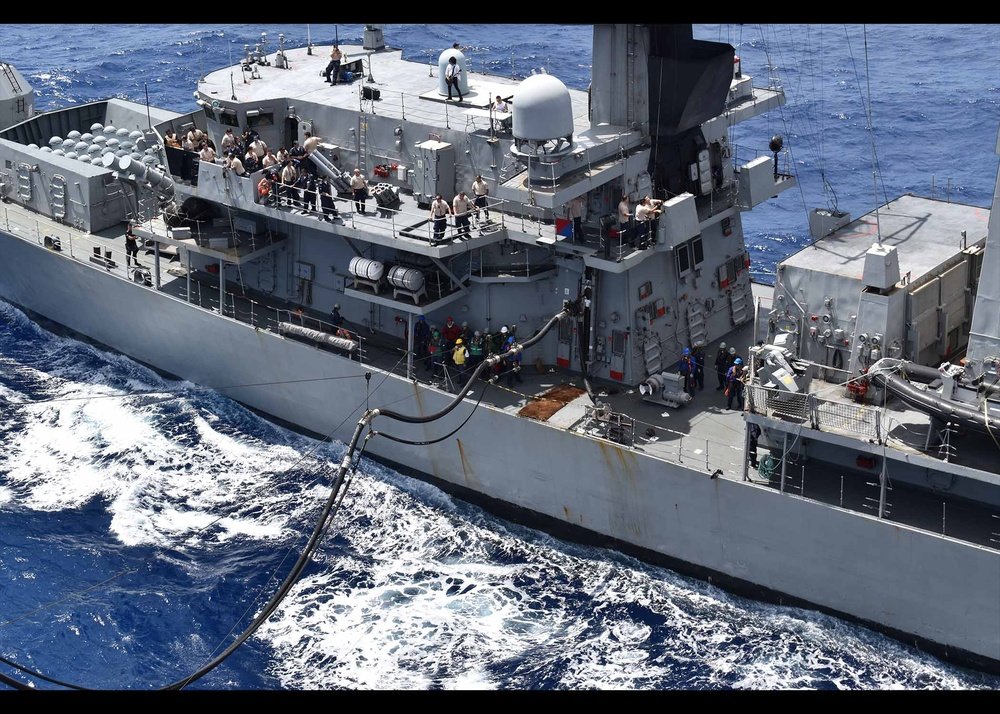Military Sealift Command (MSC) combat logistic fleet (CLF) ships have completed their support to the world’s largest, international maritime exercise, Rim of the Pacific (RIMPAC) 2024, in Hawaii.
Throughout the four-weeks long exercise, MSC fleet replenishment oiler USNS Pecos (T-AO 197), and MSC dry cargo/ammunition ship USNS Washington Chambers (T-AKE 11) delivered nearly four million gallons diesel ship fuel (DFM) through and over one million gallons JP5 aviation fuel, and 1256 pallets of food, dry stores, mechanical parts, supplies and mail, to U.S. Navy and U.S. Coast Guard, and foreign navies’ through a series of 101 replenishment at sea evolutions.

While moving cargo is a day’s work on an MSC CLF ship, the RIMPAC operations tempo is unlike a regular day, where a ship may service one or two ships. During RIMPAC, the operations tempo could see the CLF ships service up to ten ships a day, with underway replenishments (UNREPS) being conducted on both sides of the ship with U.S. Navy and foreign navy ships.
“Supporting RIMPAC gives us the opportunity to provide UNREP services to the numerous allied countries who are participating,” said Capt. Keith Walzak, Pecos’ civil service master. “This allows both us and them to do real time actual alongside operations, which without an event like RIMPAC would leave questions as to the abilities of the naval ships to be able to get those same services in a real wartime environment. As a duty oiler, the ship’s mission is to provide services for the local fleet, be it in San Diego, or Pearl Harbor. In RIMPAC, everyday has the ship providing some sort of service, or role-playing different types of ships for the training of the engaged forces.”

As a multi-national exercise, RIMPAC’s unique aspect is the interaction between participating countries and the U.S. Navy. This is true for MSC ships as well, who provided logistics services to foreign navy ships during the exercise. Working with crews whose first language is not English, can prove challenging. For this reason, fostering relationships, before getting underway for the exercise, helped increase the communications with all the ships, making the UNREP evolutions smoother.
“One of the biggest challenges is communications,” explained Nathan Wheeler, Washington Chamber’s civil service Operations Chief. “One of the best ways to overcome these challenges is to host meet and greet visits onboard the vessel while in port, which Washington Chambers has done with countries such as the Republic of Korea.”

With the closing of the Navy’s fuel terminal at Red Hill, MSC CLF ships received fuel through a series of consolidated cargo operations (CONSOLs) with two MSC chartered tankers; Overseas Mykonos and Allied Pacific. The two tankers delivered over two million gallons of JP5 and DFM through 17 CONSOLs with the MSC ships and to the New Zealand Navy’s Polar-class sustainment vessel HMNZS Aotearoa (A11).
The key to meeting the demands of RIMPAC is MSC’s ability to work in concert, directly with Commander Third Fleet and Commander Task Force 173. The MSC Representative Pearl Harbor coordinated the delivery of food and stores, as well as the pierside time at the correct pier for the loadouts of cargo to the specific ships scheduled for later RAS.
“Being part of RIMAPC allows us to participate with other nations that have common goals, and ideologices,” said Walzak “There have been multiple events scheduled, ashore to allow all the RIMPAC participants to gather together, and share cultures. The best one was 4th of July fireworks.”

